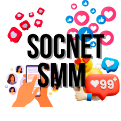Tutorial How To Create a Funny Caricature Effect in Adobe Photoshop
-
Posts
-
Offline Links Another mirror ?
-
SocNet is now on Medium! Check out our new article showcasing the full potential of our store and SMM Panel! Article: Click 🚀 Promo code: MEDIUM5 (5% Discount) ➡️ Online Store: Click ✅ ➡️ Telegram Bot: Click ✅ ➡️ SMM Panel: Click ✅ Regular customers receive additional discounts and promo codes! Support: ➡️ Telegram: https://t.me/solomon_bog ✅ ➡️ Discord: https://discord.gg/y9AStFFsrh ✅ ➡️ WhatsApp: https://wa.me/79051904467 ✅ ➡️ Email: solomonbog@socnet.store ✅ ➡️ Telegram Channel: https://t.me/accsforyou_shop ✅ You can also contact us for: — Wholesale inquiries — Partnership opportunities (Current partners: https://socnet.bgng.io/partners ) — Becoming a supplier SocNet — your store for digital goods and premium subscriptions ✅
-
SocNet is now on Medium! Check out our new article showcasing the full potential of our store and SMM Panel! Article: Click Promo code: MEDIUM5 (5% Discount) Online Store: Click Telegram Bot: Click SMM Panel: Click Regular customers receive additional discounts and promo codes! Support: Telegram: https://t.me/solomon_bog Discord: https://discord.gg/y9AStFFsrh WhatsApp: https://wa.me/79051904467 Email: solomonbog@socnet.store Telegram Channel: https://t.me/accsforyou_shop You can also contact us for: — Wholesale inquiries — Partnership opportunities (Current partners: https://socnet.bgng.io/partners ) — Becoming a supplier SocNet — your store for digital goods and premium subscriptions Want to expand your business network or promote services through the largest B2B platform? LinkedIn accounts are your tool for marketing, recruiting, and outreach automation. Perfect for SMM, hiring, lead generation, and business scaling. ➡ Ready-made accounts — fast, convenient, no hassle. Promo code: LINKEDIN5 (5% discount) Payment: Bank cards · Cryptocurrency · Other popular methods How to buy: ➡ Online Store: Click ➡ Telegram Bot: Click Other services: ➡ SMM Panel: Click Product range: ➡ LINKEDIN.COM ACCOUNTS | EMAIL INCLUDED @OUTLOOK.COM / @HOTMAIL.COM / @FIRSTMAIL.COM, MALE OR FEMALE, PARTIALLY FILLED PROFILES, REGISTERED FROM USA IP | Price from: $2.5 ➡ LINKEDIN.COM ACCOUNTS | EMAIL INCLUDED @OUTLOOK.COM / @HOTMAIL.COM / @FIRSTMAIL.COM, MALE OR FEMALE, PARTIALLY FILLED PROFILES, REGISTERED FROM EUROPE IP | Price from: $2.5 ➡ LINKEDIN.COM ACCOUNTS | EMAIL INCLUDED @OUTLOOK.COM / @HOTMAIL.COM / @FIRSTMAIL.COM, MALE OR FEMALE, PARTIALLY FILLED PROFILES, REGISTERED FROM MIX IP | Price from: $2.5 ➡ LinkedIn Old Brute Account with Real Connections (0 connections) | Mix Geo | Filled Profile | Registered on real device | Price from: $10 ➡ LinkedIn Premium Brute Account (Premium) with active 1-month Premium subscription | Geo: MIX | Registered on real device | Full account access | Price from: $20 ➡ LinkedIn Old Brute Account with Real Connections (50 connections) | Mix Geo | Filled Profile | Registered on real device | Price from: $20 ➡ LinkedIn Old Brute Account with Real Connections (100+ connections) | Mix Geo | Filled Profile | Registered on real device | Price from: $39 ➡ LinkedIn Old Brute Account with Real Connections (500+ connections) | Mix Geo | Filled Profile | Registered on real device | Price from: $69 ➡ LinkedIn Verified Brute Account with verified documents | Geo: MIX | Registered on real device | Full account access | Price from: $89 Loyal customers — additional discounts and promo codes! Support: ➡ Telegram: https://t.me/solomon_bog ➡ Discord: https://discord.gg/y9AStFFsrh ➡ WhatsApp: https://wa.me/79051904467 ➡ Email: solomonbog@socnet.store ➡ Telegram Channel: https://t.me/accsforyou_shop Also via these contacts you can: — Consult about wholesale purchases — Set up a partnership (current partners: https://socnet.bgng.io/partners ) — Become our supplier SocNet — Digital Goods and Premium Subscriptions Store
-
SocNet is now on Medium! Check out our new article showcasing the full potential of our store and SMM Panel! Article: Click Promo code: MEDIUM5 (5% Discount) Online Store: Click Telegram Bot: Click SMM Panel: Click Regular customers receive additional discounts and promo codes! Support: Telegram: https://t.me/solomon_bog Discord: https://discord.gg/y9AStFFsrh WhatsApp: https://wa.me/79051904467 Email: solomonbog@socnet.store Telegram Channel: https://t.me/accsforyou_shop You can also contact us for: — Wholesale inquiries — Partnership opportunities (Current partners: https://socnet.bgng.io/partners ) — Becoming a supplier SocNet — your store for digital goods and premium subscriptions Want to expand your business network or promote services through the largest B2B platform? LinkedIn accounts are your tool for marketing, recruiting, and outreach automation. Perfect for SMM, hiring, lead generation, and business scaling. ➡ Ready-made accounts — fast, convenient, no hassle. Promo code: LINKEDIN5 (5% discount) Payment: Bank cards · Cryptocurrency · Other popular methods How to buy: ➡ Online Store: Click ➡ Telegram Bot: Click Other services: ➡ SMM Panel: Click Product range: ➡ LINKEDIN.COM ACCOUNTS | EMAIL INCLUDED @OUTLOOK.COM / @HOTMAIL.COM / @FIRSTMAIL.COM, MALE OR FEMALE, PARTIALLY FILLED PROFILES, REGISTERED FROM USA IP | Price from: $2.5 ➡ LINKEDIN.COM ACCOUNTS | EMAIL INCLUDED @OUTLOOK.COM / @HOTMAIL.COM / @FIRSTMAIL.COM, MALE OR FEMALE, PARTIALLY FILLED PROFILES, REGISTERED FROM EUROPE IP | Price from: $2.5 ➡ LINKEDIN.COM ACCOUNTS | EMAIL INCLUDED @OUTLOOK.COM / @HOTMAIL.COM / @FIRSTMAIL.COM, MALE OR FEMALE, PARTIALLY FILLED PROFILES, REGISTERED FROM MIX IP | Price from: $2.5 ➡ LinkedIn Old Brute Account with Real Connections (0 connections) | Mix Geo | Filled Profile | Registered on real device | Price from: $10 ➡ LinkedIn Premium Brute Account (Premium) with active 1-month Premium subscription | Geo: MIX | Registered on real device | Full account access | Price from: $20 ➡ LinkedIn Old Brute Account with Real Connections (50 connections) | Mix Geo | Filled Profile | Registered on real device | Price from: $20 ➡ LinkedIn Old Brute Account with Real Connections (100+ connections) | Mix Geo | Filled Profile | Registered on real device | Price from: $39 ➡ LinkedIn Old Brute Account with Real Connections (500+ connections) | Mix Geo | Filled Profile | Registered on real device | Price from: $69 ➡ LinkedIn Verified Brute Account with verified documents | Geo: MIX | Registered on real device | Full account access | Price from: $89 Loyal customers — additional discounts and promo codes! Support: ➡ Telegram: https://t.me/solomon_bog ➡ Discord: https://discord.gg/y9AStFFsrh ➡ WhatsApp: https://wa.me/79051904467 ➡ Email: solomonbog@socnet.store ➡ Telegram Channel: https://t.me/accsforyou_shop Also via these contacts you can: — Consult about wholesale purchases — Set up a partnership (current partners: https://socnet.bgng.io/partners ) — Become our supplier SocNet — Digital Goods and Premium Subscriptions Store
-
-
Topics











Recommended Posts
Join the conversation
You can post now and register later. If you have an account, sign in now to post with your account.
Note: Your post will require moderator approval before it will be visible.